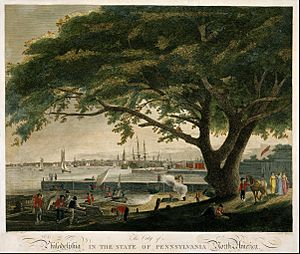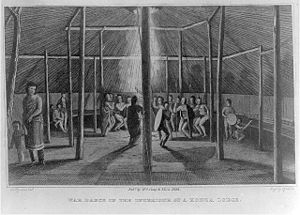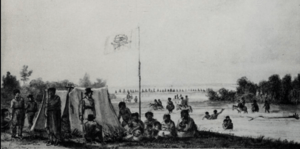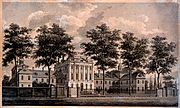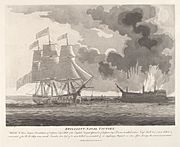Samuel Seymour (artist) facts for kids
Samuel Seymour (born around 1775, died around 1832) was a talented artist. He was a painter, engraver, and illustrator. He is famous for drawing Native American people and beautiful landscapes. He created these drawings during expeditions led by Stephen Harriman Long in 1819, 1820, and 1823. Some of his pictures even showed new types of plants and animals.
People called him "the first artist to explore the far western parts of America." Seymour was born in England or Scotland. He moved to the United States when he was young. He learned to be an engraver, which is someone who carves designs onto metal plates for printing. Later, he started painting landscapes. His art was shown at the Pennsylvania Academy of the Fine Arts.
Contents
Early Life of Samuel Seymour
Samuel Seymour was born around 1775. He came from either England or Scotland. As a young man, he moved to the United States. He received training to become an engraver.
Seymour's Work in Philadelphia
In 1795, Seymour created five pictures for an American version of the Encyclopædia Britannica. This was a very important book. By 1796, he had settled in Philadelphia. He worked there as an engraver and painter until 1822. He often worked with other artists like Thomas Sully. He also made engravings of William Birch's art.
After the American Revolutionary War, Philadelphia was rebuilt. Birch and Seymour worked together on a picture of Brooklyn Heights. They made two different versions on one engraving plate. Both pictures showed churches and many different people. Ships were on the river. One version even had people having a picnic. The prints from these engravings were colored by hand. One of his famous engravings is of Thomas Birch's 1811 drawing, Philadelphia, taken from Kensington. You can see it at the Philadelphia Museum of Art.
Seymour's art was shown at the Pennsylvania Academy of the Fine Arts. His work was displayed alongside very famous artists. He was part of a group of artists and scientists. This group included the Peale family, John Wesley Jarvis, and Thomas Birch. The Academy owns some of his works. These include Study of a Bird and an engraving called Man directing woman into a cave. Even though he focused on his engraving business, he loved painting landscapes outdoors.
Seymour knew many important art and science groups. These included the Academy of Natural Sciences of Philadelphia and the American Philosophical Society. He became very interested in landscape painting. He would travel to the countryside with friends to sketch. He also went along the Schuylkill River to draw.
These important organizations helped plan Stephen Harriman Long's scientific trips.
Samuel Seymour's Expeditions with Major Long
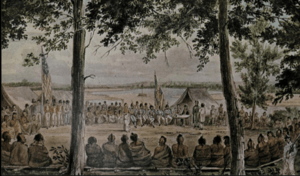
In 1819, Seymour joined a science trip to explore the Missouri River. He and another artist, Titian Peale, were the first trained artists to explore the American West. They drew amazing landscapes and pictures of Native Americans. They were also the first official artists to go with a United States government trip into the Great Plains. Seymour was with Major Benjamin O'Fallon when they met the Missouria, Otoe, and Pawnee tribes.
One of Seymour's famous watercolors shows a Pawnee council. It features military officers and a band. The Pawnee people are sitting on benches. An American flag flies high. A Native American leader steps forward to speak to everyone.
Seymour also drew pictures for Long's 1820 expedition. This trip went along the Platte River, to the Front Range of the Rocky Mountains. Then it continued along the Arkansas and Canadian Rivers.
His job was to "sketch landscapes" that were beautiful or grand. He also had to "paint portraits of distinguished Indians." He was asked to show "groups of savages celebrating their festivals, or sitting in council." Basically, he had to draw anything important for his art. For example, Seymour sketched a scene of Kansa men dancing and howling around a fire. This was the first drawing of a farming tribe and dancing Native Americans on the Great Plains. His drawings, like Kiowa Encampment, gave important information about life on the Great Plains.
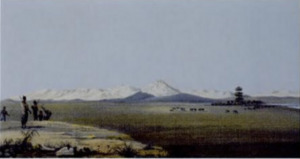
After traveling the plains for almost a month, they saw the Rocky Mountains on June 30, 1820. They were about 100 miles east of the mountains. Seymour drew the first landscape of the Rocky Mountains. It showed Longs Peak. He also sketched the Platte Canyon valley in the mountains. From there, the group moved south.
Along the Arkansas River, they found a camp of Arapaho, Cheyenne, Kiowa, and Kiowa Apache people. Seymour drew a picture of the Native American chiefs crossing the river. They were going to the expedition's camp to meet Captain John R. Bell. For three weeks, Captain Bell's group traveled down the Arkansas River. They saw Arapaho heading to battle. They also saw Comanche returning from a fight. There are no surviving drawings by Seymour from this specific time.
Long's group had split from Bell's group to follow the Red River. They met up again at Fort Smith in Arkansas Territory. This was the last stop on their trip. Seymour drew pictures of the fort. He traveled through New Orleans on his way back to Philadelphia. He arrived home in December 1820. He had created 150 drawings. These included Native Americans, wildlife, and scenery. His drawings were very accurate.
In the field, Seymour used a quick way to sketch. He would use small loops for trees and plants. Sometimes, publishers changed his drawings. For example, he drew an "Indian and white hunter" in his watercolor View of the Chasm. But these figures were removed from the final picture. This made the mountains look stark and removed the idea of a friendly meeting.
Many of his illustrations showed new types of plants and animals. Sadly, many of his works have been lost over time. Only 17 known drawings from his 1819-1820 expedition still exist today.
He went on another trip with Long in 1823. This expedition explored the Upper Mississippi River, Lake of the Woods, and the Red River of the North. They traveled to the source of the St. Peter's River in what is now Minnesota. A writer named John G. McDermott believed Seymour was the first artist to travel through this area. He wanted to capture the beautiful landscapes of present-day Minnesota. Seymour returned home by October 26. He probably finished his paintings from this trip by mid-1824.
Later Years of Samuel Seymour
A man named Samuel Seymour lived in Newark, New Jersey in the 1830s. His wife was Mary Ann. They had six children, including four daughters: Emma, Francis, Maria, and Mary. When he made his will in 1833, some of his children were still young. He gave his daughter Emma the painting Fort Smith, Arkansas, 1820.
Gallery


